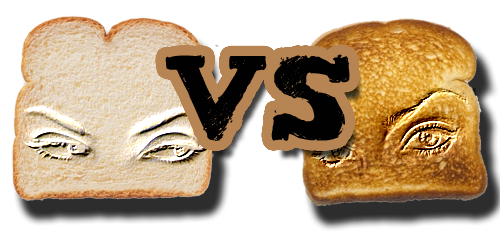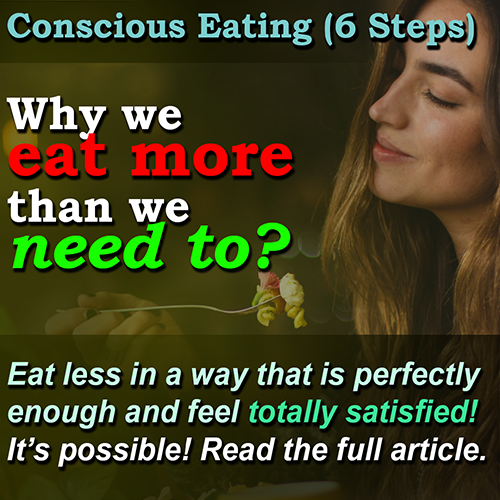
Conscious Eating (6 steps)
Find out why you eat more than you need to!
Eat less in a way that is perfectly enough, and feel totally satisfied. It's
possible. You only need to understand what is in your mind when you are eating.
1. Understanding your habits
You only need to understand what kind of thoughts are in your head when you are
eating. Your relationship with eating will change only if you know this, and
with practice.
Imagine a moment where there is a big plate full of your favourite food in
front of you. Let’s say XXXL size. Done? What do you feel now? You want to eat
it, right? And eat it fast. You want to get this fantastic meal inside your
body. It is a very old programming, coming from a very old human habit: „Eat
when you can! Who knows what happens next! What is inside is yours! No one can
take it away.” Have you ever experienced starving a lot for a specific food,
and then when you eat it, you don't even remember a single moment of consuming
it? There is the food. And the next moment, it's the empty plate. What
happened? Familiar? It's not a coincidence: it's one of the most difficult
things to be present in these moments.
2. Ok, but what can we do?
Only listen. Listen to the voice in your head that urges you to eat a lot
quickly! Only recognizing these thoughts can free you from the need to eat
much. But you need to be very aware. You cannot make it like learning a mantra
and use it every time. Because every time you have different thoughts. And the
more thoughts you catch, the more free you are to decide what to do. Without
knowing what is in your head, you are completely defenseless to your habits.
It's difficult, because you learned not to be present when you eat. It's easy
to be present when you are meditating in a silent room. Being present in the
moment of eating is one of the biggest challenges! But don't think about this
before your meal. Don't think about it after your meal. Be present when you are
eating and watch your thoughts in the moment when you are sitting at the dining
table. In this state, you will already feel much better and much more free. You’ll
already start to feel like you are not controlled by your habits, and it's
fantastic. What should you do now? How should you eat? Watch your plate, watch
the food, and start eating slowly. Look at your hands when you are touching the
fork, sticking it to the food and look at it before you eat it. You don't need
to be extra slow. You will feel it is the normal tempo! It'sdifferent,
but good. You don't feel any urge to eat it fast. If you do it right you will
realize now you aren’t thinking about other things (your problems, your work, and
what to do next). You were always thinking about something else while eating.
Now you give all your attention to eating. It's a fresh experience without any
need.
3. The actual eating process
And now comes the most difficult part. It comes when you taste the food. You
will feel an urge to take another bite quickly, but if you recognize this urge,
it is gone in the moment. Stay present. Listen to the taste. Let me show you an
example. I'm sure you have been to a standing reception, right? Where everyone
tries to show their perfect selves. And you notice your favourite snack is on
the table. You want to eat it all. It's such a shame you have this feeling, you
start feeling awkward inside. But only getting one piece of that snack is okay.
So you go there and get one, and eat it. How great! Wow! It's fantastic. You
know why it was so fantastic? It's the same food you buy for yourself
sometimes. But now it's much better! Maybe you'd think that it is because it's
free. Nooo. Don't think that you are so cheap. :) The difference is because you
had only one bite and you were present in the moment when you tasted it. And
you were present because you really WANTED to TASTE IT! Is that as good as it
looks? Is that salty enough? You don't think about anything else in this
situation, and this makes that one bite much more valuable than eating a whole
pack of the same food at home. Even if it's too salty, it is not a big issue.
You feel good not because of the food itself, but because you became aware and
listened to the exact moment when you consumed that food. And you became one
with that moment. Which always makes you feel good and free. Unfortunately, a
moment later, you already start to think again about eating more. But it's alright
too. Our job is not to judge any of our behaviours in our head, but to see
them. So let's get back to the moment where you are at the dining table, and
you taste your food. You should consume that bite the same way as you do it in
a standing reception. And you have to do it for every bite. The experience of
eating will be totally different. You will realize you don't feel an urge to
eat big pieces. Eating little pieces are just as satisfying. And you will
realize you are chewing it for a lot longer. There is no urge. You don't just
bite and swallow, you chew it for seconds and listening to the beautiful
variety of every aspects of the taste. I tell you this may seem very easy, but
I think it's one of the most difficult things to do from the start until the
end. But the more aware you are of your eating, the more satisfied you will be
when you are finished. Much less portions will be enough. It's not because you
tricked your stomach by extending the duration of feeling full because of this
effect. It is because you KNOW that you are eating, and you are aware of that.
It will be more satisfying to eat a smaller portion this way, than eating a big
portion quickly. When you eat a big portion quickly, sometimes you can realize
that you are still hungry. I mean, in your head! You want to eat more, but you
feel your stomach doesn't let you eat more. You have eaten a big portion and
you are still not satisfied some way. You need to be present to realize that
how unsatisfying your old eating habit is. Eating consciously will make your
body satisfied, and you won't feel that
you need anything more. When you unconsciously eat a big portion you will feel
bad afterwards. You say it was because you stuffed your stomach. It's only the
physical manisfestation in the body which tells you "My friend, you missed
the point. You better do it differently next time". But we don't hear it,
we just think we feel bad because we ate so much. Sometimes, we even lie to
ourself saying that "OOOh, that was sooo good", and we hold our stomach
to prevent it from blowing out. But you can't lie to your body, it will always
send you signs.
4. How to practice it?
You will feel a great urge sometimes to unconsciously eat the old way: "I
wanna eat again without listening to the moment! I just wanna eat that whole
pizza, I don't care!". If that’s the case, don't feel bad. Eat the whole
pizza. But when you let yourself do this, you will know what you are doing, and
this experience will help you in the future. The temptation will be less from
time to time. Never judge yourself when you eat a whole pizza without even
realizing it. Always know that when you realize that you didn't realize what
you were doing, it means that you are REALIZING what you doing, and it's
enough. It's perfectly okay. You don't need to be a pro in a day. What's
more: you don't need to be a pro at all. This thing is working for itself, you
don't really have to do anything. The more time you realize what you are
doing/or what you were not doing, it only means you are more conscious of your
eating. So you can't make a mistake. One could say the only mistake you can do
is not realizing anything, but what is not realized is like something what never
happened. So there is nothing to worry about :).
5. Portions
Okay, but how do you decide how much to eat? You don't wanna eat too little, or
too much. If you were a "pro" you wouldn't need any help in this. And
you could stop eating in the moment when it's enough. But I don't know if
anyone is on this level :)). Here comes calorie counting into the picture. As
calories are the fuel of the body, they represent the amount of food your body
needs. Fortunately, we have this tool to calculate the exact amount which our
body needs. When setting your diet plan, I want to encourage you not to set low
calorie limits. Test it for some days. In our old habits, we could easily eat
2500-35000 calories a day. The best option is to just track your calorie intake
without any restriction for the first days. It will give you a picture of how
much you usually eat. Let's say it is 3000 kcal per day. It's not
extraordinary. If you set a 1200 calorie limit now, you will give up your diet
in a few weeks. You need to find the limit where you are not hungry, or where
you can tolerate the hunger very easily. If you are hungry, your diet plan is
wrong. You will give it up, or what's worse, you’ll expose yourself to
suffering for a long time. The calorie limit should be set on a level which you
can maintain for months! The key is that the diet should be easy! The whole
calorie counting method should only serve the goal to help you find the right
limit for what your body needs. The goal of your body is to also be healthy.
It's not only your goal. Your body wants to eat the right amount. Not more, not
less. And the right amount is in match with your perfect weight.
6. Our site
I've created this website to help you in this process. I want to give you a
guide to how many calories you should eat, and to help you to keep this level. We are so used to bad eating habits, so we need this tool to realize our own
needs. By clicking here you can calculate your calorie needs. I hope this website will guide you through this process the easiest and
most comfortable way. If you learned the "lesson", you won't need it
anymore. Never feel bad if you "cheat" your limit. The goal is not to
"not-cheat", but to find your perfect needs. Overeatings also
helps you to experience the working of your body. Never feel ashamed. Just
acknowledge it, and track it without guilt. :)
I hope you found this article useful. If you did, please share it. I'm
personally very interested in your responses, so don't hesitate to write me on
Facebook, or here in the forum.
Our gift to new users
Our site has been working in Hungary for 6 years, and we launched the English
version in January 2019. Now we’re giving a gift for the first 1000 users,
which contains extra features: a 2 months Premium Membership (which works only
for the English version). Please note that our site is free to use forever
without any limitation, and the Premium Membership contains only some extra
features to cover our maintenance costs.
Thank you for reading,
Mate
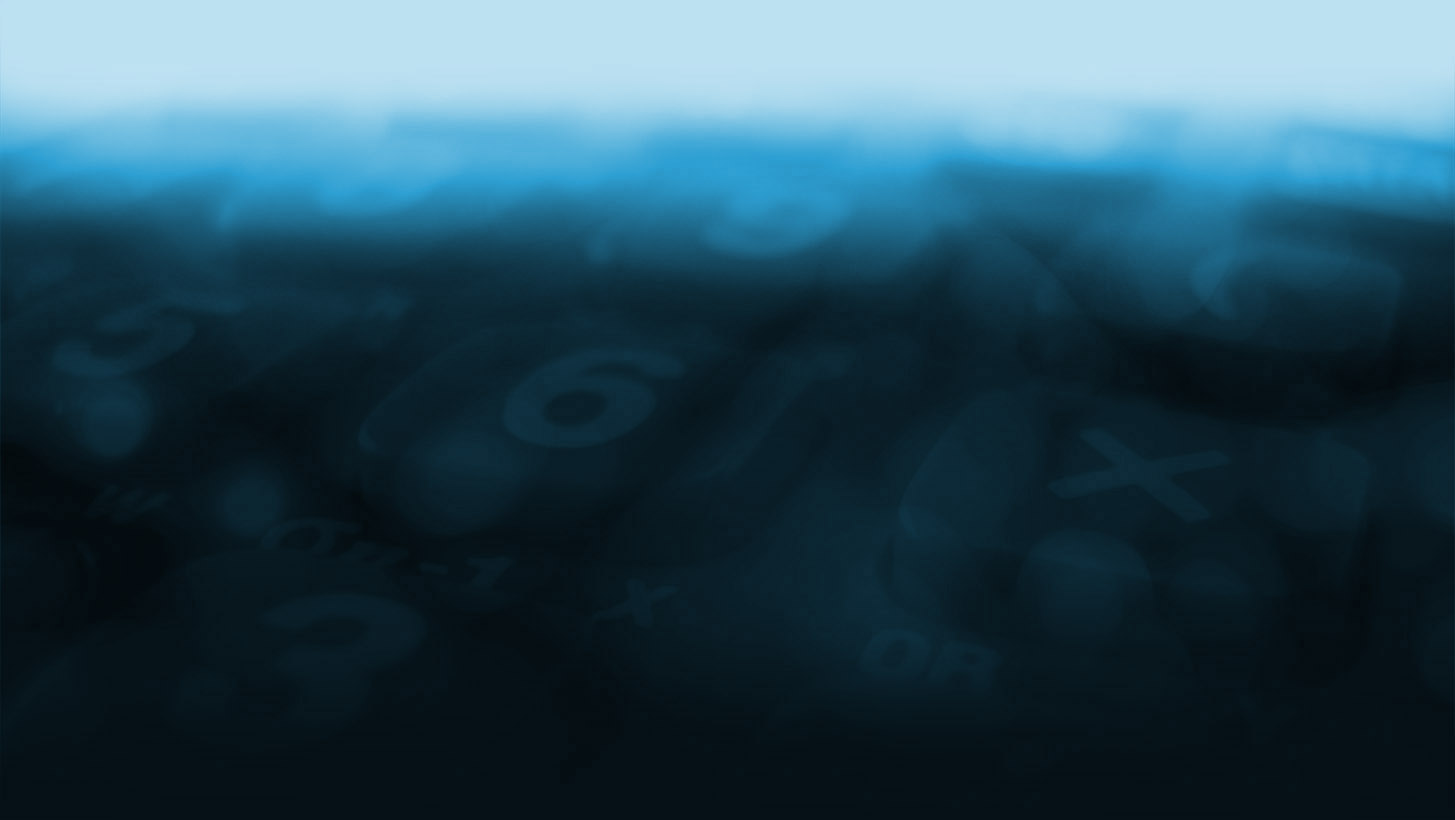

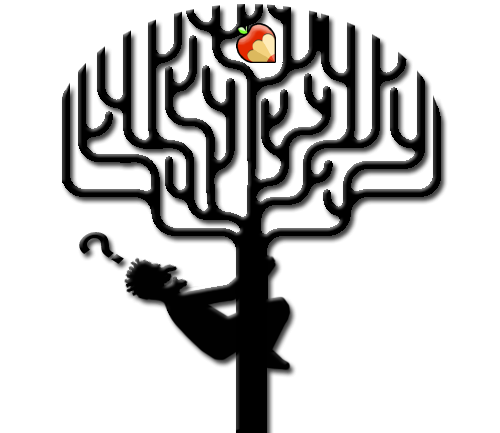
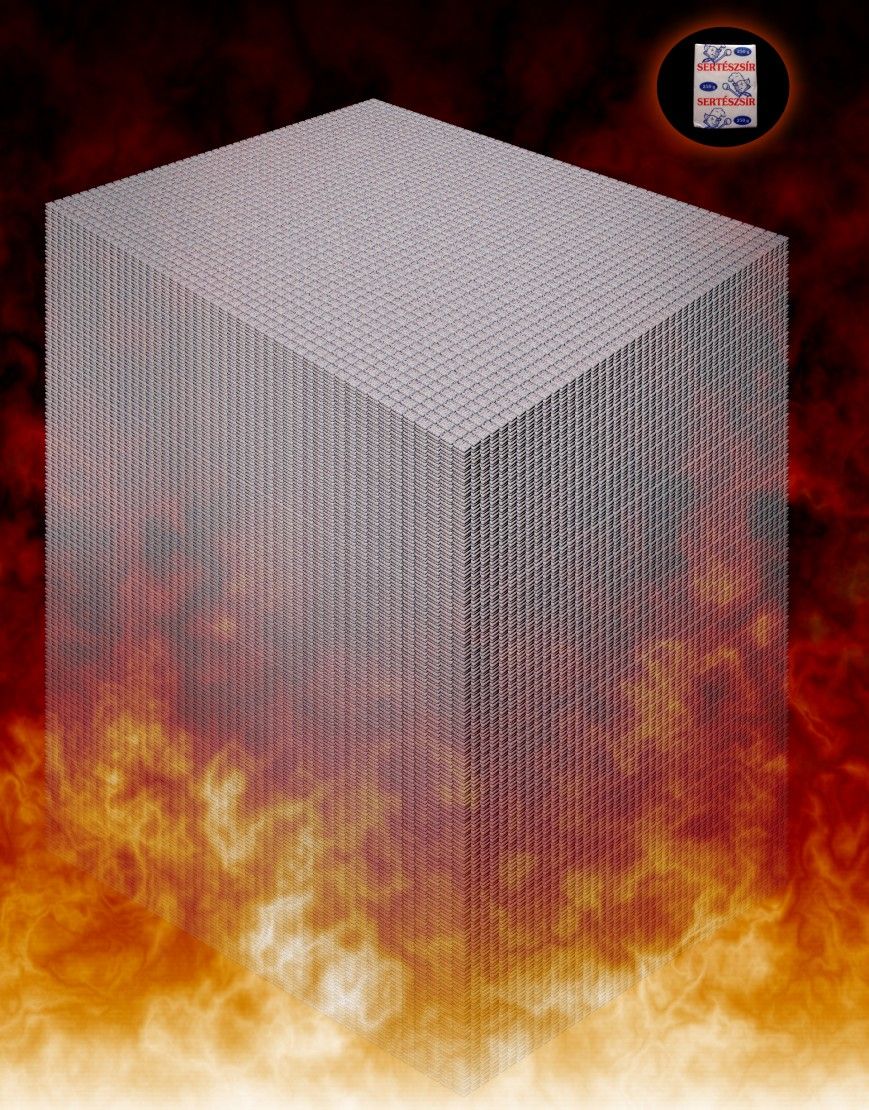
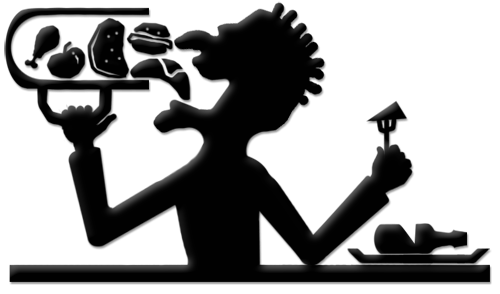

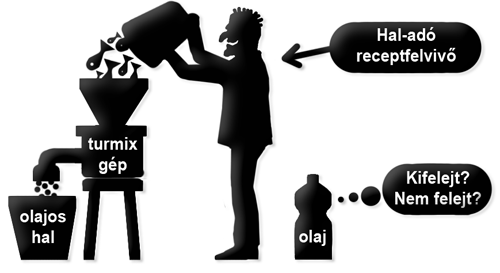
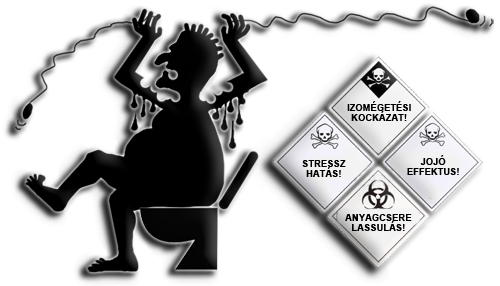

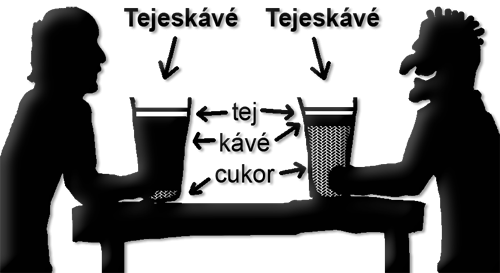
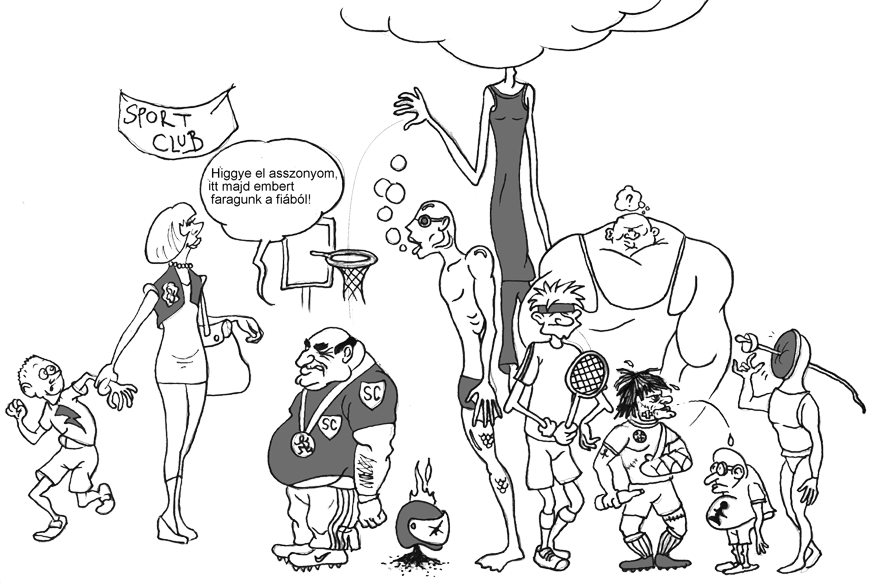 Find your own sport! :)
Find your own sport! :)
